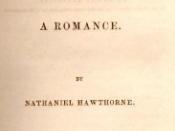The Scarlet Letter shows a dystopia created by the Puritans The Puritans who lived in the mid seventeenth century were arduously trying to create a model society, also known as a utopia. The Scarlet Letter, by Nathaniel Hawthorne, was written primarily to show that the Puritans were creating the opposite of a perfect society - Massachusetts Bay colony is displayed as a dystopia instead. Throughout the story, Hawthorne proves this irony by exposing the flaws of society. The Puritans' hypocrisy, Hester Prynne, and the ordeals she has to overcome, are examples used by Hawthorne to show Americans that creating a utopia is not an easy task, and may turn unexpectedly wrong.
The Puritans came to North America with the idea of creating a utopia, but Hawthorne depicts their hypocrisy throughout the novel, proving Massachusetts Bay to be a flawed society. The main character, Hester Prynne, is very skillful with needlework, and this is first seen when she emerges from the prison with a beautifully embroidered "A" upon her bosom.
Here, Hawthorne exposes the Puritan's hypocrisy. In this chapter, onlookers are appalled by her "brazen" design; however, by chapter five, her needlework has become "the fashion," adorning many of the Puritans' clothing articles. This goes against what the Puritans believe a person should wear because they are supposed to wear somber clothes, and not such "extravagances." Hester's needlework is colorful, ornate, and glamorous; however, women repeatedly desire it. Regardless of Hester's embroidery becoming popular, society still "frowned upon her sin." Another example of Puritanical hypocrisy is Governor Bellingham's house. His house is so magnificent and shiny that it does not seem to be the dwellings of a Puritan ruler, but "Aladdin's Palace" instead. In addition, the governor's hall resembles a British mansion a great deal, which is hypocritical because...



A very Interesting take on the Novel!
Very, very interesting. I must say, among other things, dystopic literature didn't come into my mind for the Scarlet Letter until now. Your analysis was good, and yet, perhaps you could also mention some of the aspects of the novel, like love, Chillingworth, Dimsdale, Pearl, and the inner strength of women. For example, inconsistencies within the novel include the influence of the "devil," and how Chillingworth, once a respectable man, becomes transformed. There is a whole world of examples illustrating the potential dystopia in Hawthorne's novel. Overall, good. (89)
0 out of 0 people found this comment useful.